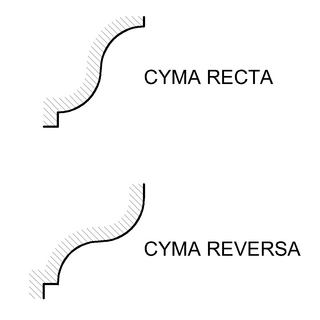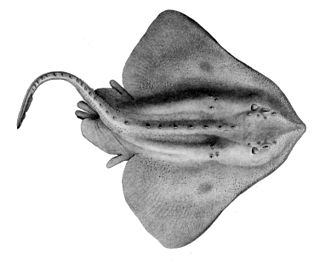
An ogee ( ) is the name given to objects, elements, and curves—often seen in architecture and building trades—that have been variously described as serpentine-, extended S-, or sigmoid-shaped. Ogees consist of a "double curve", the combination of two semicircular curves or arcs that, as a result of a point of inflection from concave to convex or vice versa, have ends of the overall curve that point in opposite directions.

In biology, a type is a particular specimen of an organism to which the scientific name of that organism is formally attached. In other words, a type is an example that serves to anchor or centralize the defining features of that particular taxon. In older usage, a type was a taxon rather than a specimen.

An egg case or egg capsule is the casing that surrounds the eggs of oviparous sharks, skates and chimaeras. Egg cases typically contain one embryo, except for big skate and mottled skate egg cases, which contain up to 7 embryos. Oviparity is completely absent in the superorder Squalomorphii.

Heliobatis is an extinct genus of stingray in the Myliobatiformes family Dasyatidae. At present the genus contains the single species Heliobatis radians.

Raja, also known as raia, is a genus of skates in the family Rajidae containing 16 species. Formerly a wastebasket genus, many species historically placed here have been moved to other genera in the family, such as Amblyraja, Beringraja, Dipturus, Leucoraja and Rostroraja. Raja are flat-bodied, cartilaginous fish with a rhombic shapes due to their large pectoral fins extending from or nearly from the snouts to the bases of their tails. Their sharp snouts are produced by a cranial projection of rostral cartilage. The mouth and gills are located on underside of the body. They may be either solid-coloured or patterned, and most skates have spiny or thorn-like structures on the upper surface, and some species contain weak electrical organs within their tails. Mating typically occurs in the spring and the female lays numerous eggs per clutch which are encapsulated in leathery cases, commonly known as "mermaid’s purses". Species vary in size, ranging from about 40 to 140 cm (1.3–4.6 ft) in length. These bottom-dwellers are active during both day and night, and typically feed on molluscs, crustaceans and fish. Raja skates are found in the East Atlantic, including the Mediterranean, and western Indian Ocean, ranging from relatively shallow water to a depth of 800 m (2,600 ft). Skates and related species have fossil records dating from the Upper Cretaceous period, thus this well adapted species is quite ancient.
The thickbody skate is a species of fish in the family Rajidae found off the coasts of Argentina, Chile, and Uruguay. Its natural habitat is open seas.

Amblyraja is a genus of skates that primarily are found in the Atlantic, but species also occur in the East and North Pacific, the Arabian Sea, the sub-Antarctic, and off Southern Australia and New Zealand.

Histioteuthis reversa, commonly known as the reverse jewel squid or the elongate jewel squid, is a species of cock-eyed squid, so called because the eyes are dissimilar. It occurs at moderate depths in the Atlantic Ocean and Mediterranean Sea and is also known from the Indian Ocean.

The broad skate is a poorly known species of skate in the family Rajidae. It occurs at depths of 846 to 2,324 metres, and has been observed via remotely operated underwater vehicle by the Monterey Bay Aquarium Research Institute as deep as 3,167 metres (10,390 ft), making it one of the deepest-occurring skates known. It is sporadically distributed in the Pacific Ocean, from the Gulf of Panama to British Columbia and the Bering Sea, to the Tohoku Slope off northern Honshu and the Okhotsk Slope off Hokkaido. The species name, badia, comes from the Latin batius meaning "brown", referring to its color.

The thorny skate is a species of fish in the family Rajidae. This bottom-living skate lives in the North and south-eastern Atlantic Ocean in depths ranging from 20 to 1,000 m (66–3,281 ft) and water temperatures from −1 to 14 °C (30–57 °F).
The bigmouth skate is a species of fish in the family Rajidae. It lives near the bottom in deep waters in Southeast Atlantic in depths below 1000 m. Its maximum size is 77 cm. It has a hard, roughly triangular snout and smooth body with star-based thorns around its eyes, tail, and elsewhere. Its top side is dark gray and underside has white spots. As the name suggests, it has a large mouth.

The Arctic skate is a species of fish in the family Rajidae. It lives near the seabed between 140 and 2,500 m deep in the Arctic Ocean and waters around Canada and northern and north-western Europe, in the northern Pacific Ocean, and in waters surrounding Antarctica and New Zealand.
The southern thorny skate is a species of fish in the family Rajidae. It lives off the coast of Argentina and Uruguay, and around the Falkland Islands in depths ranging from 51 to 642 m. Its maximum size is 69 cm. It lays oblong egg capsules with horn-like projections at the corners which are laid in sandy or muddy flats. The eggs measure 86.4 mm in length and 56.2 mm in width.
Chaoyangia is an extinct genus of euornithean birds, containing the single species Chaoyangia beishanensis. This species is known from a single fossil specimen consisting of a partial skeleton including vertebra, ribs, hips, and upper legs. The specimen was discovered in the Jiufotang Formation near the city of Chaoyang in Liaoning province, China. This rock formation has been dated to the Aptian age of the Early Cretaceous period, 120 million years ago.
Jensen's skate, also known as the shortail skate, is a poorly known species of fish discovered in 2004 during a study of bottom ichthyofauna aboard the Norwegian RV G.O. Sars, where four species were identified, including A. jensieni.

Juratyrant is a tyrannosauroid dinosaur genus from the late Jurassic period of England. The genus contains a single species, Juratyrant langhami, which was once classed as a species of Stokesosaurus.
Eudactylina corrugata is a species of parasitic copepod found on the little skate and the thorny skate that is only known from St. Andrews, New Brunswick and Woods Hole, Massachusetts.
Amblyraja taaf, commonly known as the whiteleg skate or thorny skate, is a little-known skate found at depths ranging from 150 to 600 m. It has been located off Crozet and Kerguelen Islands. Other specimens have been found off the coast of South Africa and Madagascar, but may be unrepresentative of the skate's native regions. Because of the limited knowledge of its biology and extent of capture in fisheries, this species is assessed as data deficient.
Brochiraja aenigma, also known as the Enigmaskate, is a skate known from a single specimen recently identified in 2006. Based on the single specimen, its range includes at least the Wanganella Bank on the Norfolk Ridge. It is rare with further searches finding no specimens, and while it is not commonly fished or reported in commercial distribution, it can be used for fish meal.
Kompsornis is an extinct genus of avialan that lived during the Early Cretaceous period of China. The type and only known species is Kompsornis longicaudus; the specific name means "long-tailed". It is known from only a single fossil specimen from the Jiufotang Formation. Kompsornis was closely related to the well-known Jeholornis, another long-tailed avialan from China, but differs from it in features of its skeleton, particularly the fusion and growth rate of its bones. Like other jeholornithiforms, Kompsornis was a long-tailed avialan with long wings and possessed little or no teeth, with none identified in the single specimen of Kompsornis.










